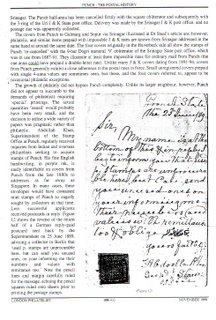 Besides these two covers that bear multiples of the Poonch first issues, there are two addition covers with multiples (but detached stamps and not pairs) of the 1876 issue recorded. One was last seen in the Robson Lowe auction of December 1967 (lot 398) and is described as "1876 6p. red three examples, one very fine used with India 1/a blue on reverse of an envelope which also has India 1/2 anna blue and 1 anna brown on the front". The fourth bears two 6 pies of 1876 and three 1 anna of 1880.
Besides these two covers that bear multiples of the Poonch first issues, there are two addition covers with multiples (but detached stamps and not pairs) of the 1876 issue recorded. One was last seen in the Robson Lowe auction of December 1967 (lot 398) and is described as "1876 6p. red three examples, one very fine used with India 1/a blue on reverse of an envelope which also has India 1/2 anna blue and 1 anna brown on the front". The fourth bears two 6 pies of 1876 and three 1 anna of 1880. Seals Used in Poonch : There were two intaglio seals in existence in Poonch , one that has been called as the "Poonch Seal" with four lines of Dogri inscription reading "Shri Raghnath ji sahai mohr dak khana riyasat Punch Samvat 1933" and the second called the "Kahuta Seal" and reading "Shri Raghnath ji sahai mohr dak khana riyasat Punch 39" .
 The Kahuta seals seems to have been exclusively used for sorting purposes ( a receipt mark) and never as an obliterator. The only exception being on an outgoing British Indian registered stationary envelope which shows the Kahuta seal applied to the front of the cover as a despatch mark.
The Kahuta seals seems to have been exclusively used for sorting purposes ( a receipt mark) and never as an obliterator. The only exception being on an outgoing British Indian registered stationary envelope which shows the Kahuta seal applied to the front of the cover as a despatch mark.Literature
Stamps of Poonch - Douie, Philatelic Journal Of India 1932
Poonch: The Postal History by A.S.Bard
Valuation
Looking at Stanley Gibbons catalogue, the more rare of the tete-beche varieties are valued at multiples of 100-1000 times the ordinary stamp (e.g. the semi tete-beche variety of SG12, SG52 are all catalogued at a multiple of 1000). Note that this tete-beche is not rare but unique! In addition what multiple would you estimate for the stamps being on cover (in very fine condition) in combination usage with a British India postal stationary?





















 These are rare. In 1972 Jal Cooper had believed only one such pair existed. However, a few have appeared in auction since then and based on the Robson Lowe(September 1986), David Feldman (1986) , and Spink (Sep 2001) sales, I would estimate around 20/30 such covers to be in existence.
These are rare. In 1972 Jal Cooper had believed only one such pair existed. However, a few have appeared in auction since then and based on the Robson Lowe(September 1986), David Feldman (1986) , and Spink (Sep 2001) sales, I would estimate around 20/30 such covers to be in existence.

























